No Obstacle Too Great
Parkour practitioners may look like crazed daredevils, but there is a solid philosophy behind their moves: You can overcome anything

|
You may have seen Parkour around town, on TV or the Internet, but didn’t know what to make of it: guys and sometimes girls bounding around handicap ramp rails, jumping from rooftop to rooftop or using overly elaborate ways of getting from one point to another.
A McDonald’s commercial shot in downtown Honolulu features a young businessman leaping around the city’s obstacles, with McDonald’s bag and ice cream cone in hand, trying to get to work on time.
The most memorable - and over-the-top - portrayal of such street acrobatics is seen in the Bond flick Casino Royale when the British agent chases a bomb-maker around the streets of Madagascar - bounding from high rooftops to the ground and fighting on top of construction equipment. This is a good example of what Parkour is about: Escape, no matter the obstacle.
However, what appears to be a lot of flips, running and wall climbs is actually a discipline that takes commitment, training and focus both mentally and physically.
“Parkour the sport is also a philosophy,” says Hawaii Parkour founder and organizer Ozzi Quintero, who also starred in the McDonald’s commercial. “We believe if we train the body and mind to overcome the physical obstacles that get in our way, then why not use the same mindset to overcome the mental obstacles in daily life?”
Parkour essentially means “the path,” and is a physical art form dedicated to getting an individual from point A to point B using the objects that usually deter most, like walls and fences, as an advantage.
“We don’t see obstacles. We see opportunities to use our minds to create a particular solution for whatever is in our way,” Quintero says.

|
Quintero himself started Parkour for the wrong reasons. “I’ve always been a natural monkey,” he says, listing several other extreme activities he’s done including BMX, break-dancing and martial arts. “So when I moved to Hawaii, I was looking for a place to breakdance, but then I saw Parkour videos and said, ‘You know what? I can try this.’ But then, like I said, it was just because it was cool. I wanted be just like Jackie Chan or whatever.”
From there, Quintero went out to live, eat and breathe Parkour. “Within a couple of months I just started to try to find people around and was either learning from them or teaching them, because I had a lot of time on my hands,” he says. “I was just looking at tutorials all the time, going out to practice, and got into forums online to try to understand the philosophy and training behind it.”
Despite his auspicious attitude, Quintero started to feel the pain of an unconditioned body with the beatings his bones and joints were taking.
So he dove deeper into the history and philosophies surrounding Parkour, which, believe it or not, has been around for decades.
It all began with Georges Hebert and his journeys all over the globe in the French navy before World War I. While visiting Africa, Hebert was impressed with the physique and training exercises practiced by Africans, as well as their ability to use the environment to their advantage.

|

|

|
Thus, he created a strength-conditioning regimen called Methode Naturelle, or the “natural method.” The conditioning includes 10 fundamental groups: walking, running, jumping, quadruple movement, climbing, balancing, throwing, lifting, self-defense and swimming.
The French military began using the method to train its soldiers and trickled down to the godfather of modern Parkour’s father, Raymond Belle, who served in the French military in Vietnam during the 1950s. He instilled the training and mindset into his son, David, who took it to another level.
Belle began using the method in the streets of Lisses, France, in the late 1990s with a handful of friends and gave it the name Parkour. This new method has the same roots as the natural method, but places more of an emphasis on the urban environment.
“You can think of Parkour as an idea,” says Quintero. “It’s the mindset of overcoming obstacles rather than giving up in front of them.”
The real question is: Is it hard? The answer: Yes! I caught up with the group at a Kaneohe park, with MidWeek photographer Byron Lee, for some conditioning exercises.
“I want you to try this, Matt,” Ozzi says. “So you can write about how much you hate me afterwards.” And boy, do I.
We all sat in a circle as the sun slowly cooked our flesh and drew out the sweat soon to cover every inch of my body. We did some yoga-like poses and exercises, using mostly our own body weight to tense up our cores, strengthen our legs and work on our arms.
“How ya doin’, Matt?” one of them shouted out.
“Yeah, right!” I gasped. I was sore for the next week and a half.
Members of the local chapter are young, the eldest being 25 years old, and the youngest about 15. “First time I saw Parkour was in the media,” recalls 22-year-old David Saucedo, listing martial arts and acrobatics as his previous activities of choice. He started as a free runner (a similar urban sport without the philosophy), but enjoyed the mentality behind Parkour more, joining Hawaii PK after moving here from Texas, where he also practiced the sport. “That’s why I started getting into it,” he says, “because I started understanding it and how a person can be enlightened, and once you know about that it’s when you start doing things different.”
Apart from making older folks
Page 1 of 2 pages for this story 1 2 >
E-mail this story | Print this page | Comments (0) | Archive | RSS
Most Recent Comment(s):








